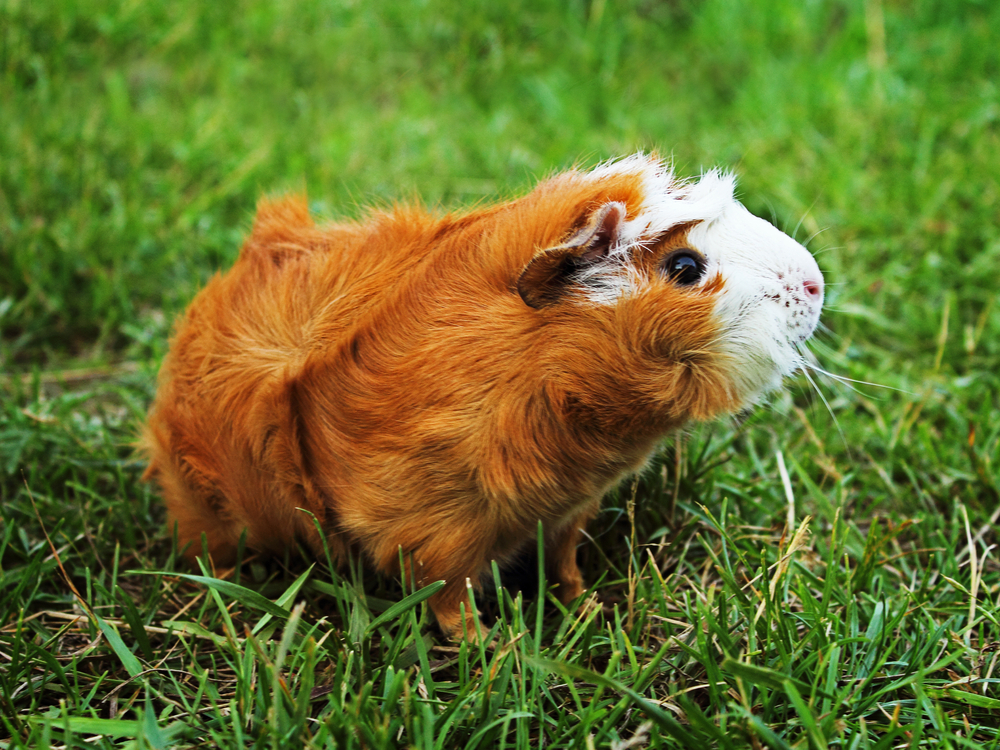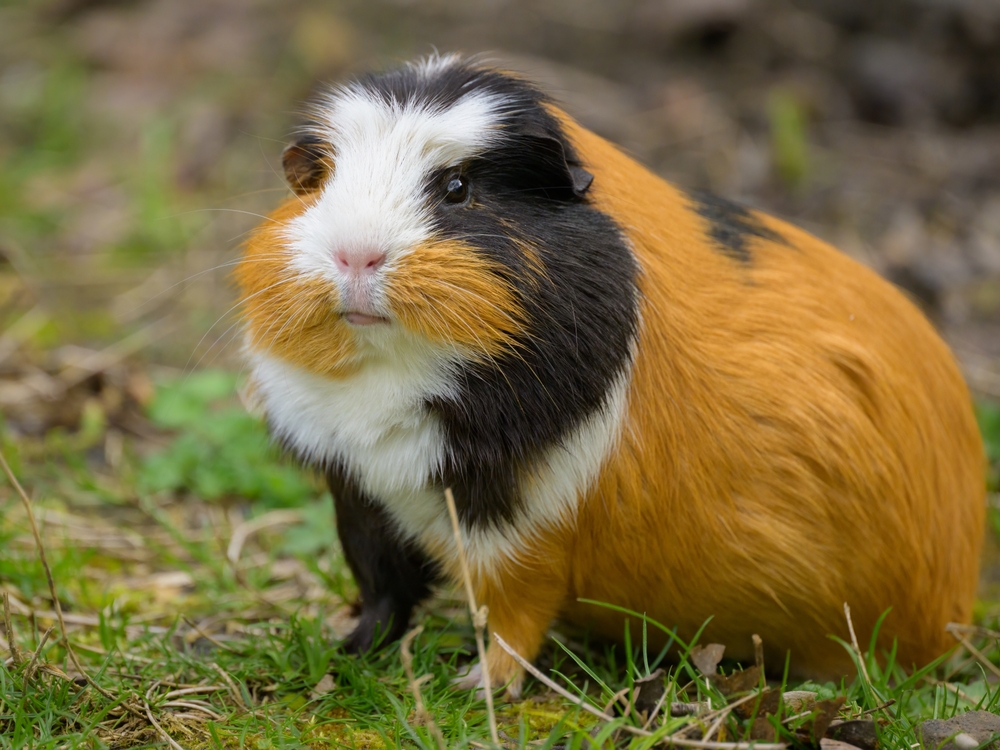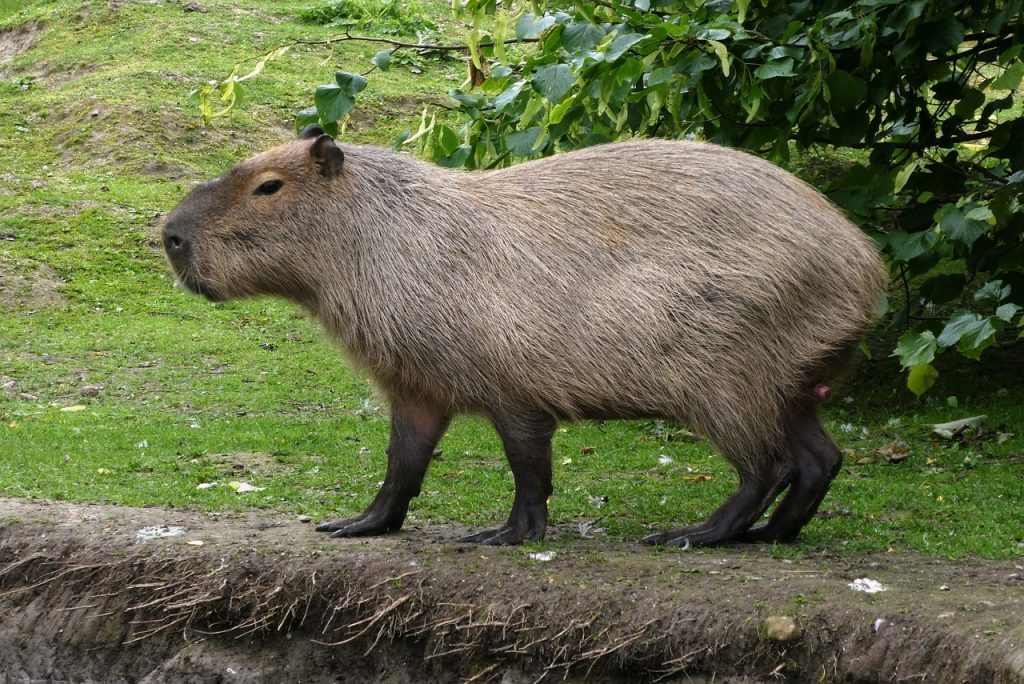The closest relatives are other domestic guinea pig breeds such as the American (smooth-coated) and the Peruvian (long-haired). All belong to the same species, Cavia porcellus. In the wild, their ancestor is the wild cavy (Cavia tschudii), native to South America.
About
The Abyssinian guinea pig is one of the most distinctive and beloved guinea pig breeds, easily recognized by its unique coat of rosettes. Unlike smooth-coated breeds, the Abyssinian’s fur grows in swirling patterns that create natural whorls across the body, typically numbering eight to ten. These rosettes give the guinea pig a tousled, spiky appearance, often described as playful or mischievous looking. Their medium-length coat can come in nearly any color or combination, from solid tones to striking multicolored patterns.
The Abyssinian guinea pig (Cavia porcellus), a member of the family Caviidae, is a domesticated rodent with origins in the Andes of South America, where guinea pigs have been kept for thousands of years. Despite its name, the Abyssinian is not from Abyssinia (modern-day Ethiopia); rather, the name was likely given to emphasize its exotic look when the breed became popular in Europe.
Abyssinians typically weigh between 1.5–2.6 pounds (700–1,200 g) and measure about 8–12 inches (20–30 cm) in length. They are lively, curious, and social animals that thrive in the company of other guinea pigs. Known for their bold personalities, Abyssinians are often more outgoing and adventurous than smoother-coated breeds, making them favorites among pet owners who enjoy interactive companions.
Their coat requires more grooming than short-haired guinea pigs, as the rosettes can trap dirt and debris. Weekly brushing helps maintain coat health and keeps their appearance neat. Like all guinea pigs, they require a diet rich in hay, supplemented with fresh vegetables and vitamin C, as they cannot produce the vitamin on their own.
With their charmingly disheveled coats, spirited personalities, and affectionate nature, Abyssinian guinea pigs are a delightful choice for families and individuals seeking an engaging small pet.
Physical Characteristics
Coat: The Abyssinian guinea pig is easily recognized by its rough, wiry coat covered in rosettes (swirls of fur that radiate outward in a circular pattern). They typically have 8–10 rosettes spread across the body, including the back, sides, and rump, giving them a spiky, tousled look. Their coat is dense and coarse to the touch, available in many colors and patterns such as solid, brindle, agouti, and bicolor.
Face: They have a broad, rounded head with large, dark eyes and short, expressive ears. Their whiskers are prominent, adding to their alert appearance.
Body: Abyssinians are medium-sized guinea pigs with a sturdy, compact build. The rosetted coat makes their bodies appear fuller and more textured compared to smooth-coated breeds.
Ears: Small, petal-shaped, and set on the sides of the head, often covered with short, fine fur.
Legs & Feet: Short legs with four toes on the front feet and three on the back, adapted for scurrying and stability rather than climbing.
Size:
-
Length: 8–12 in (20–30 cm).
-
Height: About 4–5 in (10–13 cm) at the shoulder.
Weight:
-
Adult Female (sow): 1.5–2 lbs (700–900 g).
-
Adult Male (boar): 2–2.6 lbs (900–1,200 g).
The Abyssinian Guinea Pig’s signature rosetted coat, sturdy build, and expressive face make it one of the most distinctive and visually striking guinea pig breeds, often described as having a “spiky-haired” or “whirlwind” appearance.
Reproduction
Mating and Courtship:
Abyssinian guinea pigs reach sexual maturity quite early:
-
Females (sows): 4–6 weeks of age.
-
Males (boars): 8–10 weeks of age.
Because of this, males and females should be separated early to avoid unintended litters. Courtship involves chasing, circling, and a distinctive low “rumble-strut” behavior by the boar.
Breeding Season:
Guinea pigs do not have a strict breeding season and can reproduce year-round, though breeding is safest during the sow’s first year of life.
Gestation:
The gestation period is relatively long for rodents, lasting about 59–72 days. This extended pregnancy results in well-developed (precocial) young at birth.
Birth of Pups:
-
Typical litter size: 2–4 pups, though litters can range from 1–6.
-
Pups are born fully furred, with open eyes and erupted teeth, and able to move immediately.
-
Newborns weigh around 2.8–4.2 oz (80–120 g).
Care and Nurturing:
Sows are generally attentive mothers, nursing pups for 2–3 weeks. However, because the young are precocial, they begin nibbling solid food within a few days of birth.
Weaning and Social Development:
-
Weaning occurs around 3 weeks of age, at which point pups can eat independently.
-
Separation by sex is recommended by 3–4 weeks to prevent early mating.
Independence:
By 4–5 weeks, pups are fully independent, though they continue developing socially within the herd.
Important Breeding Consideration:
Female guinea pigs should ideally have their first litter before 7–8 months of age. After this, the pubic symphysis (pelvic joint) fuses, which can make giving birth difficult or even life-threatening.
The Abyssinian Guinea Pig’s reproductive cycle is notable for its early maturity, long gestation, and precocial pups, making it different from many small mammals that give birth to helpless young.
Lifespan
Lifespan in the Home:
Abyssinian guinea pigs typically live 5–7 years, though with excellent care, some may reach 8 years or more.
Lifespan in Outdoor or High-Risk Settings:
When housed outdoors or in environments with temperature extremes, predators, or poor diets, their lifespan often drops to 3–5 years.
Factors Affecting Longevity:
-
Genetics: Abyssinians are generally hardy, but like all guinea pigs, they are prone to respiratory infections, scurvy (vitamin C deficiency), and dental issues.
-
Diet: Since guinea pigs cannot synthesize vitamin C, they must have it supplemented daily through fresh vegetables (like bell peppers or leafy greens) or fortified pellets. Deficiency leads to scurvy, drastically shortening lifespan.
-
Housing: Indoor living with proper bedding, ventilation, and protection from drafts increases longevity.
-
Exercise: Adequate space and floor time outside the cage keep them active and prevent obesity.
-
Veterinary Care: Routine health checks help catch problems early, especially with teeth and nutrition.
Notable Longevity:
While most Abyssinians live 5–7 years, a few have been recorded at 10 years, though this is rare and usually dependent on exceptional diet and care.
The Abyssinian Guinea Pig’s lifespan is largely determined by diet, housing, and preventive care, with their hardy nature allowing them to live longer than many other small rodents.
Eating Habits
Diet:
Abyssinian guinea pigs are strict herbivores and require a fiber-rich, vitamin C–supplemented diet to stay healthy. Their primary food sources include:
-
Hay: Unlimited fresh hay (timothy, orchard, or meadow hay) forms the basis of their diet, supporting digestion and dental wear.
-
Pellets: Guinea pig–specific pellets fortified with vitamin C help prevent deficiencies.
-
Fresh Vegetables: Daily servings of leafy greens (romaine, kale, parsley, cilantro) and vitamin C–rich veggies like bell peppers are essential. Small amounts of carrots, zucchini, or cucumber may also be offered.
-
Fruits: Treats like apple slices, strawberries, or blueberries can be given sparingly due to sugar content.
Feeding Frequency:
-
Constant Access to Hay: Essential for proper digestion and preventing dental problems.
-
Pellets: ⅛–¼ cup daily per adult guinea pig.
-
Fresh Vegetables: 1–2 cups daily, split into two servings if possible.
Special Considerations:
-
Vitamin C: Guinea pigs cannot synthesize vitamin C on their own, so deficiency (scurvy) is a major health risk without daily supplementation.
-
Hydration: Clean, fresh water must always be available, preferably in a bottle with a sipper tube.
-
Chewing Needs: They need continuous chewing to wear down ever-growing teeth; hay and fibrous veggies help prevent dental overgrowth.
Treats:
Occasional small amounts of fruit or special guinea pig treats are acceptable, but should not exceed 5–10% of the diet.
Feeding Enrichment:
Scatter-feeding vegetables, hiding hay in tunnels, or using foraging toys provides mental stimulation and mimics natural grazing behavior.
The Abyssinian Guinea Pig’s eating habits are defined by its need for high fiber, continuous chewing, and daily vitamin C supplementation, making diet management the most important part of its care.
Uniqueness
Rosetted Coat:
The Abyssinian’s most distinctive trait is its rosetted coat—fur that grows in circular whorls across the body. Most have 8–10 rosettes, giving them a naturally tousled, spiky look that no other guinea pig breed shares so dramatically.
Textured Appearance:
Unlike smooth-coated guinea pigs, the Abyssinian’s wiry, coarse hair makes them look perpetually “ruffled,” earning them nicknames like the “bad hair day guinea pig.”
Expressive Personality:
Abyssinians are known for being bold, curious, and mischievous. They often have more outgoing personalities compared to calmer breeds, making them entertaining and interactive companions.
High Energy & Playfulness:
They are active and inquisitive, often exploring their enclosures with enthusiasm and demanding plenty of stimulation and interaction from their owners.
Historic Breed:
The Abyssinian is one of the oldest recognized guinea pig breeds, with records dating back several centuries. Despite its name, it does not originate from Abyssinia (Ethiopia), but from South America like all guinea pigs.
Show Popularity:
Because of their striking coat, Abyssinians are a favorite in guinea pig shows. The even placement and number of rosettes are key judging features.
The Abyssinian Guinea Pig’s combination of a rosetted, spiky coat, bold personality, and historic significance makes it one of the most unique and beloved guinea pig breeds worldwide.
Be the First to Share Photos of This Species.
FAQ’s
1. What is the closest species or breed to the Abyssinian Guinea Pig?
2. How does the Abyssinian Guinea Pig compare to other guinea pigs?
The Abyssinian is more energetic, bold, and curious than many other breeds. While smooth-coated breeds like the American are typically calm and easygoing, Abyssinians are often described as mischievous and playful. Their rosetted, spiky coat makes them more visually striking and requires more grooming than short-haired guinea pigs.
3. What national parks or regions provide the best chance to see an animal resembling the Abyssinian Guinea Pig?
While domestic Abyssinians are bred in captivity, their wild relatives—the wild cavies—still roam in South America. Some prime regions include:
-
Manu National Park, Peru – Habitat for wild cavies and close to the species’ original domestication region.
-
Pantanal, Brazil – Grassland regions where wild cavies and related rodents thrive.
-
Torres del Paine National Park, Chile – Home to various cavy relatives in the open grasslands and shrub areas.





































































